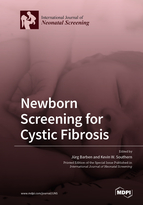Newborn Screening for Cystic Fibrosis
A special issue of International Journal of Neonatal Screening (ISSN 2409-515X).
Deadline for manuscript submissions: closed (31 January 2020) | Viewed by 39741
Special Issue Editors
Interests: newborn bloodspot screening; diagnostic tests for cystic fibrosis (sweat test); bronchoprovocation tests for asthma, acute bronchiolitis
Special Issue Information
Dear Colleagues,
Cystic fibrosis (CF) is a common life-shortening disease affecting more than 40,000 individuals in Europe and around 100,000 individuals worldwide. The outlook for patients with the disease has improved steadily over many years, largely as a result of earlier diagnosis, more pro-active therapy, and provision of care in specialized centers. The average life expectancy is now >40 years, and will increase significantly thanks to the introduction of new drugs, CFTR modulators, that target the underlying molecular defect.
The introduction of newborn bloodspot screening (NBS) for CF over the past 50 years has offered earlier diagnosis and better outcomes for children with CF in many countries. Screening for CF has been a paradigm change, and in most cases the diagnosis of CF after a positive NBS result is straightforward. A challenging sequelae of NBS has been the identification of infants with an inconclusive diagnosis after a positive screening result, which leads to uncertainty for healthcare professionals and families. The approach to these infants is evolving with increased experience and reporting of outcomes. It is important that strategies to evaluate and manage these challenging cases balance the best interests of all families, approaching this as the public health challenge it is, rather than as a diagnostic dilemma.
This Special Issue of the International Journal of Neonatal Screening on Newborn Screening for Cystic Fibrosis will focus on the state-of-the-art of the neonatal diagnosis of CF, with an emphasis on the different screening approaches and their advantages and disadvantages. It will also provide insight into the dilemma of the inconclusive diagnosis after NBS, now designated as CF screen positive, inconclusive diagnosis (CFSPID), and psychological impact on parents, as well as the monitoring of the performance of the screening.
Prof. Dr. Jürg Barben
Prof. Dr. Kevin Southern
Guest Editors
Manuscript Submission Information
Manuscripts should be submitted online at www.mdpi.com by registering and logging in to this website. Once you are registered, click here to go to the submission form. Manuscripts can be submitted until the deadline. All submissions that pass pre-check are peer-reviewed. Accepted papers will be published continuously in the journal (as soon as accepted) and will be listed together on the special issue website. Research articles, review articles as well as short communications are invited. For planned papers, a title and short abstract (about 100 words) can be sent to the Editorial Office for announcement on this website.
Submitted manuscripts should not have been published previously, nor be under consideration for publication elsewhere (except conference proceedings papers). All manuscripts are thoroughly refereed through a single-blind peer-review process. A guide for authors and other relevant information for submission of manuscripts is available on the Instructions for Authors page. International Journal of Neonatal Screening is an international peer-reviewed open access quarterly journal published by MDPI.
Please visit the Instructions for Authors page before submitting a manuscript. The Article Processing Charge (APC) for publication in this open access journal is 1600 CHF (Swiss Francs). Submitted papers should be well formatted and use good English. Authors may use MDPI's English editing service prior to publication or during author revisions.
Keywords
- Newborn bloodspot screening (NBS)
- Cystic fibrosis (CF)
- Immuno-reactive trypsinogen (IRT)
- CF screen positive
- Inconclusive diagnosis (CFSPID)
- CFTR-related metabolic syndrome (CRMS)
- Pancreatitis associated protein (PAP)
- DNA analysis
- Variant
- Public health







